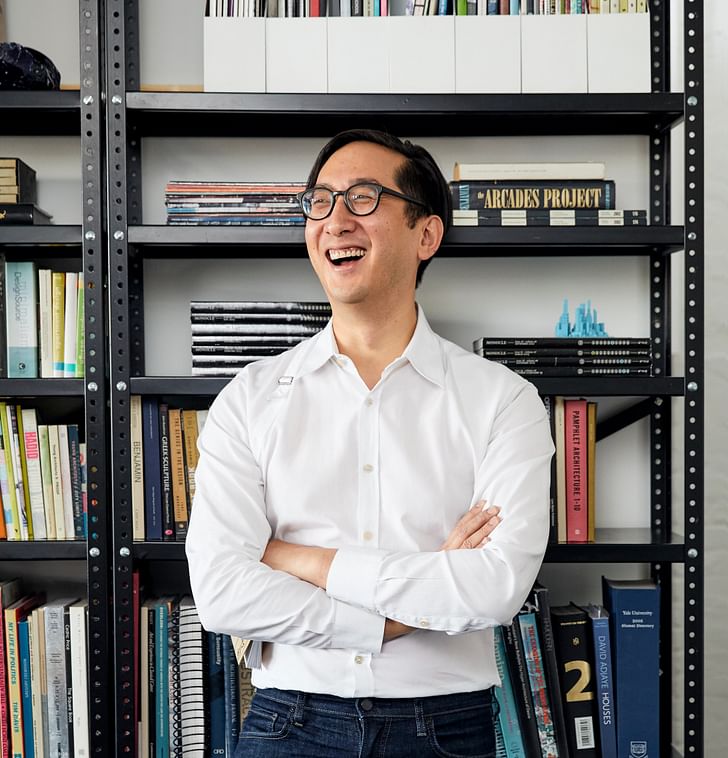

For Frederick Tang, running a practice starts with remembering where opportunities for design freedom can occur. Channeling advice given to him during the early part of his career, the Brooklyn-based architect is reminded to never forget "architecture is a service profession." An attitude that Tang has carried throughout the growth of his practice, he focuses on fostering a team that encourages design humility while prioritizing collaboration.
For this week's Studio Snapshot, Tang discusses how making big decisions for his growing firm requires understanding what it means to say "yes" or "no." As his design practice Frederick Tang Architecture evolves, so does the opportunity for exploration.
How many people are in your practice?
Our office consists of 8 people, but can vary depending on project load.
Why were you originally motivated to start your own practice?
Starting my practice emerged out of having teaching opportunities while also working a full-time job at a firm. It became difficult to balance both commitments so going independent was a way to do both. It never felt like a hard decision to make, I always knew that I wanted to have my studio even if I only took on very small projects.
I think the hardest part of having my practice is knowing when and how to say no
What hurdles have you come across?
I think the hardest part of having my practice is knowing when and how to say no. Architects are idealistic because we want to do it all!—but sometimes, we get job leads that aren't the right fit, or clients who have requests for something that we can't recommend. My instinct tends to make me always want to say yes, but that's not always the right answer. So I have to practice saying, "No, but....." Naturally, there are also the standard challenges of running a small business, (management, operations, etc.) while still reserving the bandwidth to do the design work that we want to do.
Is scaling up a goal or would you like to maintain the size of your practice?
The exact number of staff isn't a specific goal I have, as long as we have the work to support the right staff. Right now, we do a lot of interior work and I would love to expand our practice to include more free-standing, ground-up work. With around 8 people, we're at a tipping point. If larger, we would need to reconsider the studio process and organization.
What are the benefits of having your own practice? And staying small?
Being independent and small gives us the room to take on a diverse range of projects, big and small. Also, the size of our office feels like a studio in architecture school because of our tactile and exploratory process. We build physical models, create digital renderings, and really embrace a thorough examination to make the best solution. We've been lucky to work with clients who allow us the space to experiment.
Do you have a favorite project? Completed or in progress.
It's a cliché, but also true that our favorite projects are the current ones. We're especially excited when we experiment with new programs. Right now we're working with the artist Adam Pendleton on multiple projects including his studio space. The process feels very much like a dialogue. We're also designing a retail space for the men's apparel company, Mack Weldon, which is opening at Hudson Yards in March.
What's the best advice anyone has given you when it comes to your work, practice, etc?
There are two pieces of advice that I think about constantly. The first was when a boss said to me, "Never forget that architecture is a service profession." Coming out of graduate school, it felt like such a startling attitude. It encourages humility, but it also prioritizes collaboration. The second was when I was at Yale, and the Dean, Bob Stern, told us to say yes to everything. I love the inherent optimism in that attitude. Everything is an opportunity.
Cloud Tables is a new foray into product design for the firm. Can you talk about its origin and your take on furniture design?
Cloud Tables emerged from a custom dining table we designed for a client. That piece fell through, but we took those ideas and translated them into a pair of coffee tables that we made for Brooklyn Designs. Furniture design often extends out of the custom work that we already do. It's a way to test ideas on a smaller and more immediate scale. But, I'm aware that developing a full, manufactured furniture line would mean a different model for the studio and we would need to grow our practice to accommodate those ambitions.
You've designed two bookstore interiors, is your design approach different in comparison to when you're designing residential spaces?
I don't think our approach is necessarily different between the bookstores and the residential projects. The design results depend on the client preferences and goals, the environment, and the program. Our residential work is more specific to the clients because it is so personal, where commercial work takes on a bigger picture. We love the opportunity to do both kinds of work!
If you could describe your practice in three words what would they be?
Curious. Playful. Optimistic.
Katherine is an LA-based writer and editor. She was Archinect's former Editorial Manager and Advertising Manager from 2018 – January 2024. During her time at Archinect, she's conducted and written 100+ interviews and specialty features with architects, designers, academics, and industry ...
No Comments
Block this user
Are you sure you want to block this user and hide all related comments throughout the site?
Archinect
This is your first comment on Archinect. Your comment will be visible once approved.